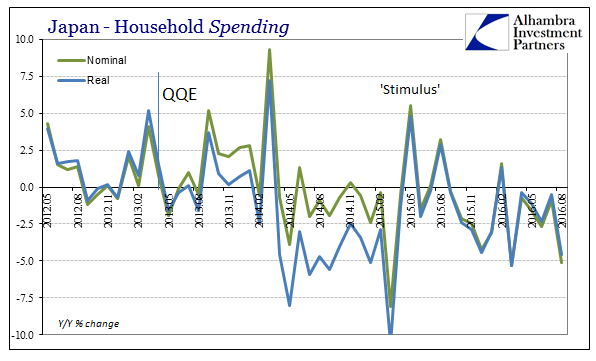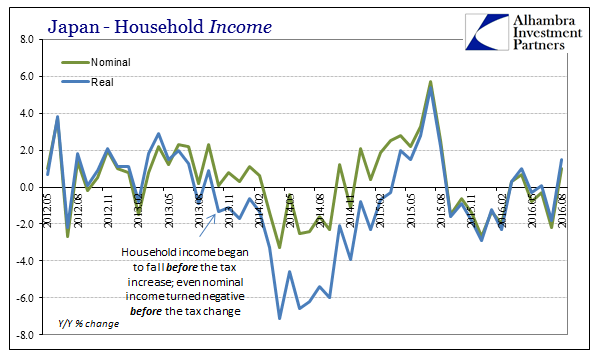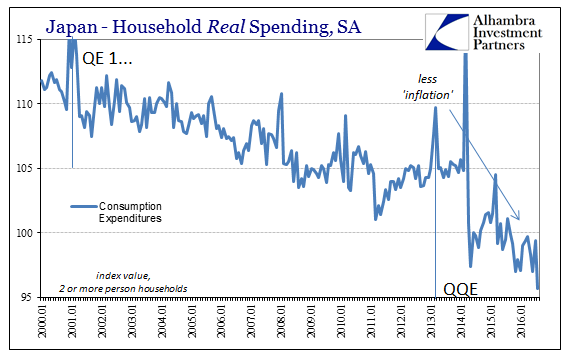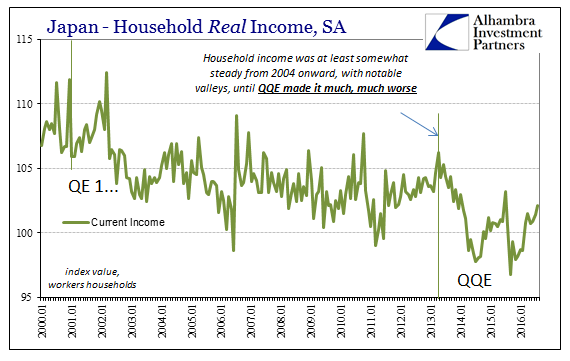Submitted by Jeffrey Snider via Alhambra Investment Partners,
In the summer of 2013, the mainstream media was already convinced that Japan’s QE amplification, the true shock and awe “money printing”, was not just working it was doing so convincingly. The yen was down sharply against the dollar, feeding what looked like a surging export sector. Even though QQE was barely a few months old, it was talked about as if Japan Inc. was all but reborn, missing only global acceptance of the brand resurrection.
In August that year, Japanese exports were reported to have jumped by 12% year-over-year for July 2013, including a nearly 20% increase in trade with the United States. Bloomberg was quite enthused about the state of global “stimulus” but none more so than that of the BoJ.
The stronger exports show Japan’s economy is benefiting from a recovery in demand in Europe and the U.S., and the yen’s 11 percent decline against the dollar this year.
But it was all an illusion; all of it. Japanese manufacturers were taking in more yen for whatever they would sell overseas, but that wasn’t the same as economic growth nor would it ever be. To economists, there was no worthwhile distinction even though they would concede that point. Activity for the sake of activity is all that mattered, including whatever is pure currency illusion. So where truly rational analysis of the Japanese economic condition saw only continuing danger (even amplified by QQE’s distortions on rhetoric and expectations as well as real economic function), the mainstream, including certain asset markets, completely bought it. As I wrote at the time:
The monetary illusion is laid bare; what looks like improvement doesn’t survive even minor scrutiny (which the media and economists simply take as gospel). The problem of such currency illusions is the disconnect between what is expected and what actually occurs. Policy expects these kinds of illusory results, but then further expects actual businesses to react to them as if they were real.
In other words, the Bank of Japan actually presumes Japanese businesses, from industry through to exporters, will hire more workers and invest in more capacity based on nothing more than this increase in currency flowing into Japan from trade. But why would Japanese businesses need more workers or capacity when they are “rewarded” with more nominal revenue by doing nothing? The Japanese aren’t shipping more goods to the US, they are just getting more yen back for the same (or actually less) quantity. This is not anything like real growth, but it counts all the same in the academic world of policymaking and commentary.
Three years later the Japanese economy has proved that it was, in fact, all nothing more than (self) delusion. There is something to be said of why the Bank of Japan in 2016 is suddenly afraid of more QQE; the Japanese economy proclaims only wreckage from what has already been offered. The yen is now in reverse, the export sector brought with it nominally, leaving the detestable baseline condition openly exposed to yet again thoroughly debunk “stimulus.”
According to the latest estimates, nominal household spending in Japan fell an enormous 5.1% in August 2016, the second time this year (March) that nominal spending has declined by more than 5%. By way of comparison, in April and May 2014, the months immediately following the tax hike, nominal spending only fell by 0.7% and 3.9%, respectively. Because the CPI is now negative again, “real” spending contracted by “only” 4.6%.

What should be most concerning to Japanese officials, however, is that spending is falling off sharply while overall income merely stagnates. In other words, ever since last summer and the sudden arrival of “global turmoil” the Japanese people have been more and more acting recessionary. Adding that contradiction to the behavior of the yen, the Bank of Japan is truly caught – both as a matter of what it can realistically achieve going forward and as evidence for what it hasn’t despite hundreds of trillions of yen in “bank reserves.”

Japan was supposed to have been shocked out of its “deflationary mindset” which is nothing more than forever ongoing economic depression. What so much monetary promise accomplished was instead to further highlight (if not prove) the glaring contradictions between what is thought of “stimulus” and what it actually is (or really is not). In May 2013, I wrote:
From the US to Europe to Asia and back again, asset prices soar while basic economic needs like jobs and incomes are left far behind; looking more like depression than a historic boom period. Central banks, almost exactly four full years after the official end to the Great Recession, are still implementing emergency monetary measures to get the global economy just moving slightly forward. It is a blatant contradiction that is seeping through into the larger consensus the more this price vs. true value disconnect grows.
At that point in tandem with the yen (don’t fight the BoJ) Japanese stocks were up an astounding 45% in anticipation of QQE and then its start; they would continue to surge, just as stock prices everywhere else did, because the full recovery was surely just around the corner. Economically, however, the incongruity of QQE (or any QE) sharpened. Household income since QQE began is down almost 4% in real terms; real household spending has fallen by more than 9%!


These are results that over time even the most thoroughly enthusiastic asset markets and mainstream supporters simply cannot ignore. You can only claim so many times that the results of “stimulus” are just delayed before all but the most ideologically unredeemable catch on that it wasn’t ever stimulus in the first place. That is likely the huge significance of last summer – the end of the monetary illusion as at least “money printing.” By that point the broad perception about QQE or all QE’s was already at least on the fence, having suffered withdrawal of so much enthusiasm during the shocking initial stages of the “rising dollar.” After last August there wasn’t much doubt left as to what monetary policy really wasn’t.
What “global turmoil” has done is to reveal the illusion even to a great many who had been quite willing to give it every chance.

So even in Japan where monetary “stimulus” has been at its most intrusive there is very good evidence that “something” changed in the middle of last year, and that there is nothing central banks or their policies can do to arrest the reversal. The Bank of Japan first tried more QQE toward the end of 2014, but that only made it worse heading into the events of last summer. Adding NIRP early this year was really Strike 3.
There is no money in orthodox monetary policy and there never really was. The only “benefit” (that some central bankers might claim) was in how some markets believed in the myth instead of realizing (quite readily) how “…asset prices soar while basic economic needs like jobs and incomes are left far behind; looking more like depression than a historic boom period.” Japan’s economy continues to be the most obvious and clear evidence of the truth in that statement, but it no less applies everywhere the monetary illusion was once accepted without question. They really don’t know what they are doing, and in 2016 it so much harder to hide.
The post There Really Is Nothing Left To The Money Illusion appeared first on crude-oil.top.
